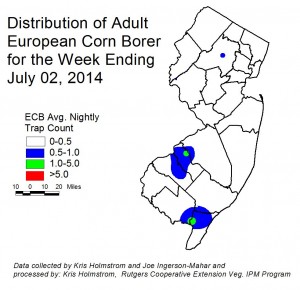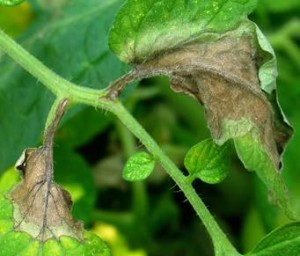Vegetable IPM Report 7-2-14 – Click to View | Download | Print
Maps for the Week
–European Corn Borer Map
–Corn Earworm Moth Pheromone Trap MapTopics for the Week
- Sweet Corn
- Peppers
- Pepper Weevil Report
- Tomatoes
- BMSB
- Pumpkins and Winter Squash
Sweet Corn
European Corn Borer (ECB) adult catches have declined to very low numbers this past week, indicating the end of the first flight. At this time, only limited catches are occurring in parts of southern Burlington south through Gloucester County and along the Cape May – Cumberland County border (see ECB map). Larval infestations in sweet corn have increased dramatically on later whorl and pre-tassel stage corn throughout the state. Infestation rates above 50% have been found in northern counties this week.
Consider treating if 12% or more plants exhibit the characteristic “shot-hole” type feeding on leaves. As plants mature to pre-tassel, live larvae and droppings can be observed in the tassels. Remember to make a full-tassel application to control ECB larvae as they leave the tassel and travel down the stalk to re-enter the plant near the ear shank. This last application is often critical to controlling ear infestations from ECB. Often, early sweet corn plantings suffer from “split set”, in which germination does not occur in a uniform fashion. The result is a planting where all plants do not reach full tassel at the same time. This situation may require an extra tassel spray if there are several days difference in the time full tassel is reached on a significant number of the plants.
| The highest nightly ECB catches for the previous week are as follows: | |||||
| Eldora | 2 | East Vineland | 1 | Oldwick | 1 |
| Springdale | 2 | Folsom | 1 | Pedricktown | 1 |
| Denville | 1 | Little York | 1 | Tabernacle | 1 |
| Downer | 1 | Medford | 1 | ||
Blacklight Trap Corn Earworm Moth (CEW): No corn earworm moths (CEW) were captured in blacklight traps this past week. We are entering the period of the summer between the low population of early moths and the late summer migration.
Pheromone Trap Corn Earworm Moth (CEW): Catches have decreased in pheromone traps in the southern counties (see CEW pheromone trap map). The blue area on the map roughly corresponds to a 5-6-day silk spray schedule, although the relatively few number of pheromone traps results in a broad blue area which does not reflect local differences. Highest activity is near western Gloucester County and from western Atlantic County north through southern Burlington. Despite the low moth numbers, sweet corn plantings now in silk in southern NJ are at risk for ear infestation if CEW is not properly controlled. As silks begin to appear, pay close attention to CEW catches in local blacklight traps, and treat silking plantings accordingly.
| The highest nightly CEW pheromone trap catches are as follows: | |||||
| Pedricktown | 2 | Indian Mills | 1 | ||
| Beckett | 1 | Woodstown | 1 | ||
| East Vineland | 1 | ||||
Silking Spray Schedules*:
South – 5-6 days
Central – 6-7 days
North – 6-7 days
*Note: These are general recommendations. Local trap catches may indicate some variation in the frequency of insecticide applications to silking corn.
Peppers
ECB larvae are now infesting pepper plants. Be sure to scout fields regularly for the presence of ECB egg masses. If two or more egg masses are found in a 50 plant (two leaves/plant) sample, consider treating even if no fruit are present. ECB infested fruit will often show a cluster of droppings near the cap where the lava has entered. The longer fruit are infested, the more likely they are to develop bacterial soft rot. Therefore increasing levels of soft rotted fruit generally signal an ECB infestation. Generally, where blacklight trap catches average one or more ECB per night (blue and green areas on the ECB map) and fruit are greater than ½” in diameter, insecticides are warranted on a 7-day schedule, if foliar applications are to be made. Coragen, applied via the drip irrigation may also be used. See the 2014 Commercial Vegetable Production Recommendations for materials useful in controlling ECB.
Joe Ingerson-Mahar reports that Beet Armyworm (BAW) have been found in Cape May County. This pest has, unusually, shown up in sweet corn, but is predominantly a pepper pest. As pepper infestations occur, information will follow.
Pepper Weevil Report
Pepper weevil counts in the traps have dropped to zero in the past week continuing to follow the pattern found last year. No reported field infestations at this time. This doesn’t mean that they won’t reappear later in the season. However, for now, no weevils is good news. There is no map for this week.
Tomatoes
Colorado potato beetle (CPB) feeding has been occurring for the past few weeks, and activity has recently reached the northern counties. Be sure to inspect fields at least weekly for the presence of adults and larvae. Field inspections should include areas adjacent to last years’ host crop (eggplant, potato and tomato, as well as the perennial weed, horsenettle). If infestations are localized it may be possible to spot treat. Remember that if a neonicotinoid insecticide (imadicloprid or related material) was used at planting, it is not advisable to use a similar product as a foliar spray, as this may hasten resistance in the local CPB population. See the 2014 Commercial Vegetable Production Recommendations for materials useful in controlling CPB.
Recent reports of Late Blight (LB) from New York and Pennsylvania serve as warning that growers should scout fields several times a week. Protectant fungicides used to manage early blight, septoria and anthracnose will offer some protection against late blight, but should LB appear in our area, systemic fungicides would also be necessary. LB infected foliage collapses rapidly, with leaves and petioles appearing to have been “crushed”. At the margins of the infection, a whitish haze of spores may be visible. This sporulation appears similar to powdery mildew, but infected tissue nearby will be much more heavily damaged than would be the case from a powdery mildew infection. As infected leaves collapse, they often remain dark green rather than turning dry and brown, as with early blight.
Brown Marmorated Stinkbug (BMSB)
BMSB activity has again declined to extremely low numbers in blacklight traps. Overall, adult activity continues to be well behind in 2014. As adult captures increase to 5/night in parts of the state, maps will be produced to show where activity is highest. Information on scouting, crop injury and control will also be included.
| At present, the highest nightly BMSB catches are as follows: | |||||
| Belvidere | 1 | Denville | 1 | ||
| Farmingdale | 1 | Little York | 1 | ||
Pumpkins and Winter Squash
These crops are beginning to run in many areas. Cucumber beetles are much less of a threat to these larger plants, and insecticides are rarely necessary. It is important to limit the use of broad spectrum insecticides at this time, as bees are actively pollenating flowers. As fruit begin to appear and enlarge, the appearance of powdery mildew (PM) will follow. Until PM lesions develop, there is no need for fungicides targeting that pathogen. Check upper and lower surfaces of 2 mature leaves per plant on 5 consecutive plants each, in 10 locations throughout the field. When PM lesions are found on 2 or more leaves, begin a weekly protectant fungicide program. See the 2014 Commercial Vegetable Production Recommendations for materials useful in managing PM.
A sentinel plot containing susceptible and resistant cucumber varieties, as well as muskmelons, watermelons, acorn and butternut squash and pumpkins is now established at the Snyder Research and Extension Farm in Hunterdon County and another will be established at RAREC in mid-July. The purpose of these plots is to detect the presence of downy mildew (DM) in northern NJ. Vines are beginning to run, and no DM has been observed in the plot. Any occurrence will be reported in this newsletter and will also generate an alert to all subscribers. For more information on the regional presence of DM as well as comprehensive, weekly forecasts, see the following website: http://cdm.ipmpipe.org/
All current and archived Vegetable IPM Maps including European corn borer, corn earworm and brown marmorated stink bug population maps are available for viewing @
http://tinyurl.com/njaes-ipm-maps




